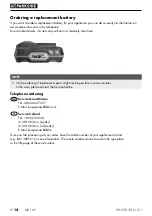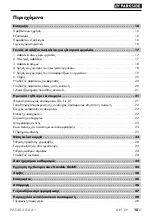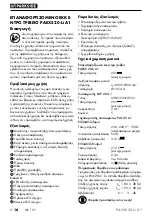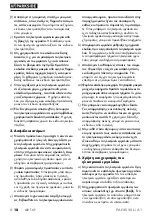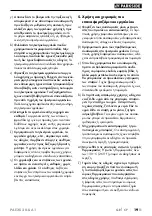
PAEXS 20-Li A1
■
4
│
GB
│
CY
e)
When working outdoors with an electrical
power tool, always use extension cords that
are also suitable for use outdoors.
Use of a
cord suitable for outdoor use reduces the risk of
electric shock .
f)
If operating a power tool in a damp location
is unavoidable, use a residual current device
(RCD) protected supply.
Use of an RCD reduces
the risk of electric shock .
3 . Personal safety
a)
Stay alert, watch what you are doing and
use common sense when operating a power
tool. Do not use a power tool while you are
tired or under the influence of drugs, alcohol
or medication.
A moment of inattention while
operating a power tool may result in serious
personal injury .
b)
Use personal protective equipment. Always
wear eye protection.
Protective equipment such
as a dust mask, non-skid safety shoes, hard hat
or hearing protection used for appropriate condi-
tions will reduce personal injuries .
c)
Prevent unintentional starting. Ensure the
switch is in the off-position before connecting
to power source and/or battery pack, picking
up or carrying the tool.
Carrying power tools
with your finger on the switch or energising
power tools that have the switch on invites
accidents .
d)
Remove any adjusting key or wrench before
turning the power tool on.
A wrench or a key
left attached to a rotating part of the power tool
may result in personal injury .
e)
Do not overreach. Keep proper footing and
balance at all times.
This enables better control
of the power tool in unexpected situations .
f)
Dress properly. Do not wear loose clothing or
jewellery. Keep your hair and clothing away
from moving parts.
Loose clothes, jewellery or
long hair can be caught in moving parts .
g)
If devices are provided for the connection of
dust extraction and collection facilities, ensure
these are connected and properly used.
Use of dust collection can reduce dust-related
hazards .
h)
Do not allow yourself to get lulled into a false
sense of security and do not ignore the safety
rules for power tools, even if you are familiar
with the power tool after repeated use.
A careless action can cause severe injury within
a fraction of a second .
4 . Power tool use and care
a)
Do not force the power tool. Use the correct
power tool for your application.
The correct
power tool will do the job better and safer at
the rate for which it was designed .
b)
Do not use the power tool if the switch does
not turn it on and off.
Any power tool that can-
not be controlled with the switch is dangerous
and must be repaired .
c)
Disconnect the plug from the power source
and/or remove the battery pack, if detachable,
from the power tool before making any ad-
justments, changing accessories, or storing
power tools.
Such preventive safety measures
reduce the risk of starting the power tool acci-
dentally .
d)
Store idle power tools out of the reach of
children and do not allow persons unfamiliar
with the power tool or these instructions to
operate the power tool.
Power tools are
dangerous in the hands of untrained users .
Summary of Contents for PAEXS 20-Li A1
Page 3: ...A...
Page 21: ...PAEXS 20 Li A1 GR CY 17 ah 10 6 m s2 K 1 5 m s2 ah 18 6 m s2 K 1 5 m s2 1 2...
Page 22: ...PAEXS 20 Li A1 18 GR CY 3 4...
Page 23: ...PAEXS 20 Li A1 GR CY 19 5 130 C 265 F...
Page 24: ...PAEXS 20 Li A1 20 GR CY 6 8 PAP 20 A1 PAP 20 A2 PAP 20 A3 www Lidl de Akku...
Page 25: ...PAEXS 20 Li A1 GR CY 21 PARKSIDE 10 C 40 C 50 80 0 C 50 C A LED LED...
Page 26: ...PAEXS 20 Li A1 22 GR CY LED LED 15 LED...
Page 27: ...PAEXS 20 Li A1 GR CY 23...
Page 28: ...PAEXS 20 Li A1 24 GR CY 0 1 6 Kompernass Handels GmbH 3...


















